Windows Can't Read the Disk in Drive E
In this commodity we will larn how to repair Windows bootloader on a modern computer that uses UEFI instead of BIOS and GPT disk partitioning table (instead of MBR). The corruption of the Windows bootloader can occur after installing a second OS (in Dual Kick configurations), incorrect actions during Windows recovery, removal of some data on subconscious partitions, malicious software (virus, ransomware, etc.) and for some other reasons.
This article provides a stride-by-pace guide for recovering a damaged or deleted bootloader on Windows 10 and Windows 8.1 on computers running in native (non-legacy) UEFI mode. The guide should help if Windows doesn't boot due to missing or damaged boot configuration file \EFI\Microsoft\Boot\BCD.
Contents:
- The boot configuration information for your PC is missing: EFI\Microsoft\Kicking\BCD
- Automatic Windows Bootloader Recovery
- Using BCDBoot to Manually Repair EFI Bootloader in Windows 10
The boot configuration data for your PC is missing: EFI\Microsoft\Kick\BCD
A computer with Windows 10 installed in native UEFI mode will fail to kick if the EFI bootloader is corrupted. When trying to boot the figurer, the following BSOD (Blueish Screen of Decease) error appears:
The boot configuration information for your PC is missing or contains errors. File :\EFI\Microsoft\Boot\BCD Error lawmaking: 0xc000000f
or:
Error lawmaking: 0xc000014c
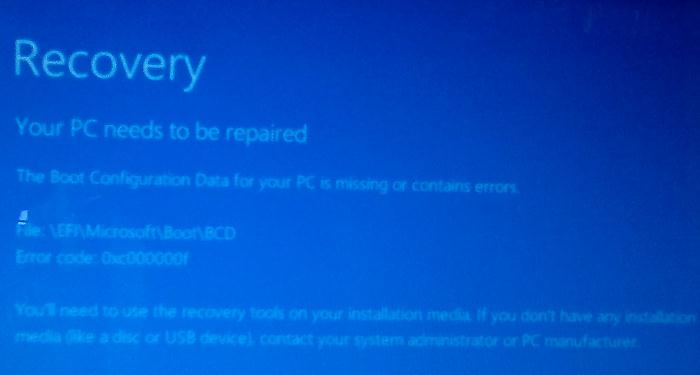
This error indicates that the Windows bootloader configuration – Boot Configuration Data (BCD) has been corrupted or even completely removed. If yous try to repair the bootloader on a UEFI computer using the bcdedit tool, you will receive an error similar this:
The boot configuration data store could not be establish. The requested system device cannot be institute.
The fact is that if Windows 10 is installed in native UEFI style on a GPT deejay, then the Windows ten EFI bootloader (Windows Boot Manager) stores the boot manager and BCD configuration on a separate hidden EFI book (100 MB in size with the FAT32 file system). The bcdedit tool doesn't come across this EFI partition, and cannot manage the bootloader configuration on information technology.
If the calculator boots with a black screen with the message "Operating System non plant", nigh likely the Windows bootloader is completely removed. Follow the instructions on the link.
Automatic Windows Bootloader Recovery
The procedure for the automated repair of the bootloader used in the Windows Recovery Environment (WinRE), is usually useless in such cases. Simply information technology's worth a try anyway:
- Try to boot your device from the recovery disc or installation Windows 10 media;
- On the installation screen, click the Restore System;
- And then select Troubleshoot -> Startup Repair and select the OS whose bootloader you want to try to recover;
- But most likely the issue will be negative:
Automated Repair couldn't repair your PC.
Using BCDBoot to Manually Repair EFI Bootloader in Windows x
Allow'southward move on to the procedure for manually restoring the EFI Windows bootloader on a figurer with UEFI.
To repair the bootloader configuration (BCD), you have to kick from the original installation Windows 10 media (or a recovery disk or a special UEFI bootable USB flash drive). After booting into the recovery environment, you need to open up a command line: select Organisation Restore – > Troubleshoot-> Control Prompt).
Yous can run Command Prompt if y'all but have a Windows installation media at hand. To exercise this, on the first screen of Windows installation (when choosing a language and keyboard layout), printing the key combination Shift+F10 (or Shift+Fn+F10 on some laptop models).
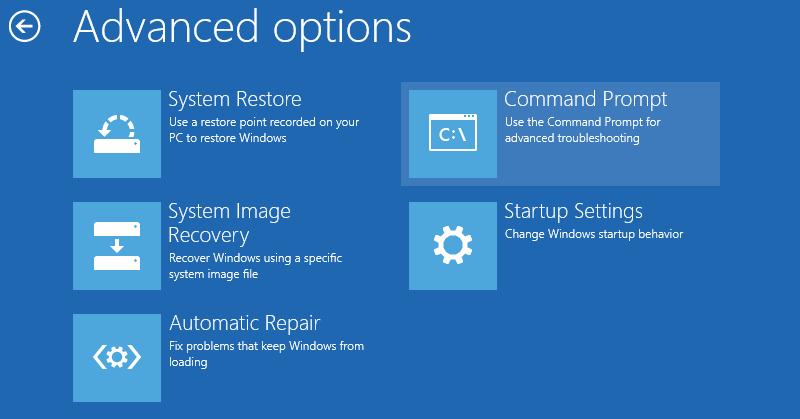
In the command prompt that opens, run the disk management tool by typing the command:
diskpart
Display the list of drives on the computer:
list deejay
At this stage, it is very important to determine the blazon of partition table on the disk on which Windows is installed: MBR or GPT. The point is that the EFI bootloader is used just on disks with a GPT partition tabular array.
If the disk has an asterisk (*) in the Gpt column, then the GPT partitioning table is used, if not, the MBR is used.

If your disk uses a GPT partition table, follow the steps below in the instructions to repair the Windows EFI bootloader.
If you have an MBR segmentation table on your disk, this instruction won't piece of work for your computer. Most likely you lot have a computer with BIOS or Legacy/Compatibility Support Mode (CSM) option enabled in the UEFI settings.
On MBR disks, the Windows bootloader is stored on a separate System Reserved partition, not on an EFI partition (in any case, don't convert the MBR partition tabular array to GPT until you prepare the Windows bootloader !!). Utilize another guide to restore the BCD bootloader on MBR (Master Kicking Record) deejay.
Select the disk with Windows installed (if there is one hard disk drive in the system, its index should be 0):
sel disk 0
Display the list of partitions and volumes on the disk:
listing sectionalisation
list volume
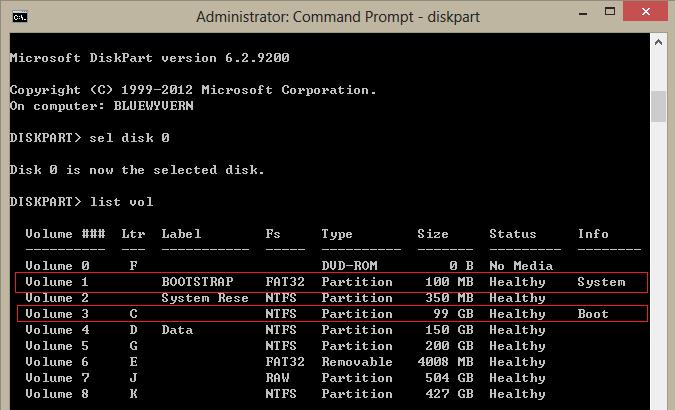
In this example, you can come across that the EFI boot partition (it can be hands identified by the size of 100 MB, and the FAT32 file system, nearly often its label is System EFI) has the partition 2 index (aka Volume 5 with the Subconscious label). The chief partition with the installed Windows with the NTFS file system (information technology can be both Windows 10 and Windows 8.i) is volume 2. There must too be an MSR (Microsoft Organization Reserved) partition of 16 MB for Windows 10 (or 128 MB for Windows 8.1).
Assign the drive alphabetic character K: to the hidden EFI volume:
select volume 1
assign letter Yard:
A bulletin that the drive letter has been successfully to the EFI partition should appear:
DiskPart is successfully assigned the drive letter or mount betoken.
Close the diskpart:
exit
Go to the bootloader directory on the hidden volume:
cd /d K:\efi\microsoft\boot\
In this case, Chiliad: is the drive alphabetic character assigned to the EFI partition just above. If the \EFI\Microsoft\Boot\ directory is missing (error The organization cannot find the path specified), try the post-obit commands:
cd /d Yard:\Kicking\
or
cd /d K:\ESD\Windows\EFI\Microsoft\Boot\
At this point, many guides recommend running the post-obit commands, which should overwrite the partition kicking record, find the installed Windows and add together them to the BCD:
bootrec /fixboot
bootrec /scanos
bootrec /rebuildbcd
or even:
bootrec /FixMbr (recovering MBR tape for a GPT disk looks strange)
All of these commands are applicable only for disks with MBR. If your computer boots in UEFI mode, so it necessarily uses the GPT partitioning table (as in our instance). Therefore, when you run bootrec commands, you volition run into an error: access is denied
To gear up boot records on an EFI partition, you need to use the BCDBoot tool. The BCDBoot tools allows yous to restore bootloader files on the system sectionalisation by copying them from the system directory on the Windows partition. The BCD bootloader configuration is recreated using the %WINDIR%\System32\Config\BCD-Template file.
Use the attrib command to remove the hidden, read-only, and system attributes from the BCD file:
attrib BCD -s -h -r
Delete the current BCD configuration file by renaming it (this will continue the sometime boot configuration every bit a backup):
ren BCD BCD.bak
Using the bcdboot.exe utility, yous need to recreate the BCD store past copying the UEFI kicking surroundings files to the kick sectionalization from the Windows directory:
bcdboot C:\Windows /l en-us /s thou: /f ALL
- C:\Windows – is the path to the directory with Windows ten installed;
- /f ALL – means that you want to re-create the Windows Boot Surround files, including those for UEFI and BIOS computers (potential power to kicking in UEFI and BIOS systems). To re-create only the EFI bootloader, use the /f UEFI command;
- /l en-united states — is a type of the system locale. By default, en-us – English language (U.s.a.) is used;
- /c – this is a new BCDBoot selection in Windows x that allows y'all to overwrite existing kicking records (including debugsettings). Use this option to ignore old boot settings and create a clean BCD configuration;
- /v – used to enable BCDBoot verbose output.
Hint. If you apply a localized version of Windows 10, the command volition be different. For instance, in the Windows version for the UK, utilize the following command
bcdboot c:\Windows /fifty en-uk /s Thousand: /f ALL
Windows 10 Dutch:
bcdboot c:\Windows /l nl-NL /s Thou: /f ALL
Windows 10 Deutch (German):
bcdboot c:\Windows /l de-DE /s K: /f ALL
Now, if you run the bcdedit control, yous will see the following :
An entry should appear in the Windows Boot Manager department containing the full path to the UEFI kicking file (\EFI\MICROSOFT\Kicking\BOOTMGFW.EFI). In this case, it is located on book ii (partition=\Device\HarddiskVolume2).
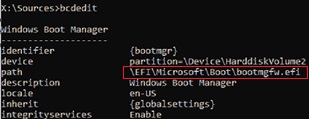
Possible errors:
- BFSVC Mistake: Could not open the BCD template store . status – [c000000f] – check if the entered command is correct and whether you have a localized Windows version installed. In this case you need specify the correct local linguistic communication code. The bcdboot tool copies the BCD template files from the \Windows\System32\Config directory. If the BCD templates in this folder are damaged or deleted, try to bank check the integrity of the organisation files offline using the
sfc.exetool (y'all demand a Windows installation disc – drive D :):sfc /scanow /OFFBOOTDIR=C:\ /OFFWINDIR=D:\WINDOWS - BFSVC Fault: Fault copying kicking files from Last Error = 0x570 – attempt to bank check bulldoze with the help of control:
CHKDSK K: /F - BFSVC Error: Failed to set chemical element awarding device. Condition = [c 000000bb ] – cheque the EFI and Windows 10 partitions with
chkdsk.exe. Verify that the hidden and system attribute of the BCD file is cleared. Remove information technology:
attrib -s -h \EFI\Microsoft\Boot\BCD
del \EFI\Microsoft\Kick\BCD
- Failure when initializing library system volume – make sure you are using the correct FAT32 partitioning with EFI (you may take several similar partitions).
Now yous demand to restart your computer and disconnect the bootable media. Then the Windows Boot Director appears in the listing of bootable devices, where you can choose desired operating organisation to boot. Your EFI bootloader and BCD configuration have been restored successfully!
Source: http://woshub.com/how-to-repair-uefi-bootloader-in-windows-8/
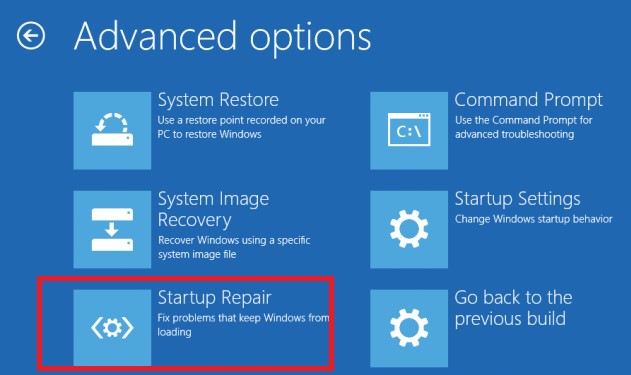

0 Response to "Windows Can't Read the Disk in Drive E"
Post a Comment